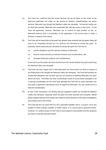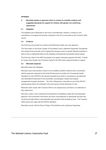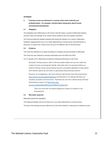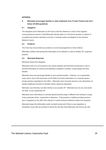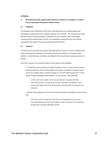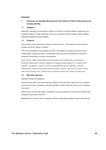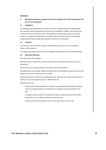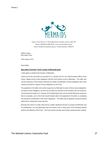Review into the award of a Reaching Communities Grant to Mermaids - The National Lottery ...
←
→
Page content transcription
If your browser does not render page correctly, please read the page content below
Mermaids Registered Charity No 1160575
Review into the award of
a Reaching Communities
Grant to Mermaids
NOTE: This report has been prepared by The National Lottery Community Fund’s
Director for Scotland for the purposes set out in 1.5. It is based on information gathered
by the Fund over a short period of time and is not intended to evaluate any medical or
scientific information. It is an internal document, written as a brief summary and guide
to assist the England Committee.
The National Lottery Community Fund 11 Introduction
1.1 At the England National Funding Panel meeting on 21st November 2018 an award of
£500,000 was made to the charity Mermaids. This was confirmed in a formal offer letter
dated 14th December 2018 from James Harcourt, England Grant-Making Director.
1.2 Following this an article appeared in the national press. This was critical of the Big
Lottery Fund for making the award and was also critical of Mermaids as an organisation,
making several allegations regarding their practice. Further articles appeared in other
outlets and social media over the next week.
1.3 Given the serious nature of the allegations made about Mermaids practice, the Big
Lottery Fund decided to undertake a review to determine whether, as a result of these
concerns, the award should be reconsidered. This is standard practice for the Fund when
complaints are made about a grant or grant-holder, although generally such complaints
are made in private and by single individuals. Mermaids were notified of the decision to
undertake the review by telephone by James Harcourt, on Monday 17th December 2018,
and this was confirmed by letter the same day. On 20th December James Harcourt
confirmed in writing the grant was paused pending the outcome of the review.
1.4 Simultaneously, a wide range of commentary was beginning to emerge on social
media. Over the course of the next week the Big Lottery Fund received over 800
representations expressing both concern and support for the organisation as well as
broader reflections on the best ways to support young people with gender dysphoria.
Correspondence was received from people with a lived experience, the parents of
children who have used the Mermaids service, people working in the field, other
members of the public and a small number of MP’s.
1.5 The purpose of the review was to:
Summarise the concerns and allegations made against Mermaids by those who made
representation to the Fund
Based on a review of standards and practice in this field and the information provided
by Mermaids, draw conclusions with reference to the allegations.
1.6 This report will provide a brief exploration of a range of aspects associated with
transgenderism, a summary of the concerns raised, an analysis of the correspondence
received, an investigation into the concerns and draw some conclusions to help the
England Committee make a final decision.
1.7 A wide range of papers, articles, commentaries and social media content have been
considered in order to develop a deeper understanding of the subject (see Annex 1). A
meeting with the organisation was held to discuss the concerns and allegations made and
to allow them to address the concerns raised. Discussions have also been held with
senior officers from the leading NHS service in England, funders and other individuals in
the field. Correspondence was also exchanged with the Charity Commission.
The National Lottery Community Fund 22 About Mermaids
2.1 Mermaids, formed in 1995, claim to be the only UK wide charity providing
information, advice support and shared experiences for transgender or non-gender
conforming children, young people (up to the age of 19) and their families. Service users
are supported via telephone helpline, email, parents’ and teens’ online forums,
residential weekends and local support groups. Its stated key aims are to; reduce
isolation and loneliness, improve self-esteem and social functioning, reduce suicidality
and self-harm in young people, and provide families with the tools to negotiate
education and health services. Mermaids other stated aims are to;
Empower families and young people with the tools they need to negotiate the
education and health services.
Reduce suicidality and self-harm in the young people who contact Mermaids and
equip their parents to support their children to the same end.
Improve self-esteem and social functioning in gender variant and transgender
children and young people.
Improve awareness, understanding and practices of GP’s, CAMHS, Social
Services and other professionals.
2.2 The organisation has developed from an unincorporated charity, solely reliant on
volunteers, with an income below £10,000 to a charitable incorporated organisation (CIO)
regulated by the Charity Commission. They have eight full time staff and an annual
turnover of £310,000. Current contacts have grown to 5,000 including 1,400 parents
group members and 500 youth group members. Its raised profile has also helped to
secure a Department for Education grant to deliver training in schools to combat
homophobic, biphobic and transphobic bullying, and raise awareness of the needs and
rights of transgender young people. Mermaids also receives funding from Trust and
Foundations including Children in Need and the Paul Hamlyn Foundation. They generate
additional income through corporate sponsorship, individual giving and other income
generating initiatives. Their growth over the last few years has required an ongoing
strengthening of the organisation’s governance, infrastructure and quality assurance
processes.
2.3 Mermaids state they work with a range of partners including the NHS Tavistock
Gender Identity Development Service, other Civil Society organisations, the Department
of Education and several other associated agencies. The organisation does not appear on
the Tavistock web site but is featured in the NHS “A Guide for Young Trans People in the
UK”1 and “A practical guide for the NHS”2 as a support and information organisation.
2.4 The proposal leading to the award of this grant was to increase localised support,
inform and improve associated services and contribute to evidence-based research on
transgender young people. Over the period of the grant the project set ambitious
targets to work with 900 families through the establishment of 45 local groups across
areas which they identified as having the highest need allied to a lack of provision.
Mermaids proposes to employ 3 Service Development Managers who will focus on the
1
Department of Health, A guide for young trans people in the UK, accessed at
https://www.mermaidsuk.org.uk/assets/media/17-15-02-A-Guide-For-Young-People.pdf
2
Department of Health, Trans: A practical guide for the NHS, available at:
http://www.edinburghtranswomen.org.uk/A_practical_guide_for_the_NHS.pdf
The National Lottery Community Fund 3following 3 areas:
Training, advice and support to parents and young people to set up their own local
support groups to help reduce isolation and loneliness and support them to develop
skills, confidence and resilience.
Deliver trans-inclusive diversity training to educate professionals and statutory
agencies on how best to support transgender children, young people and their
families.
Develop stronger relationships with universities and academia and encourage the
involvement of people who experience such issues in research projects in order to
increase understanding of the challenges faced and to identify gaps to influence
future practice.
2.5 In addition Mermaids advocates for continued development within the sector
specifically in areas associated with support to children. They state this is influenced by
the experience of children and their families, an increasing body of research in this field
and in the advancement of World Professional Association for Transgender Health
(WPATH) Standards of Care. It should be noted however there are wide ranging views in
the sector on key themes associated with supporting transgender children and young
people including issues associated with medical treatment pathways and at what age it is
appropriate to pursue such an option. This theme will be picked up in more detail later
in the report.
2.6 It is widely recognised within the field that whilst there is an increasing body of
research this is still in its infancy and requires further exploration. This features as one
of the proposed project deliverables. Mermaids have established relationships with
academics from Nottingham University and Goldsmiths University in order to participate
in planned research projects. They want to take advantage of these opportunities and
seek out more.
3. The Big Lottery Fund’s role
3.1 The Big Lottery Fund’s purpose is to support people and communities to thrive. Our
motivation is to fund initiatives that deliver the best possible services and support to people
and their communities whether this be communities of place or communities of interest.
3.2 The Fund supports a wide range of projects and activities for people across the UK
which compliment statutory provision. Our People in the Lead approach supports
learning from and developing services influenced by people’s own lived experience.
3.3 No matter what the context, the Fund seeks to be collaborative and flexible in how it
works in following the principles that underpin its People in the Lead approach.
3.4 Additionally, the Fund operates within a set of Policy Directions which are set, in the
case of the England portfolio, by the UK government.
4. The context and debate about supporting non-conforming gender identity children
4.1 The term Transgender was first coined in the early 1970’s. It is an umbrella term for
people whose gender does not conform to the sex with which they were assigned at
birth. The Transgender Identity and Research Society estimated that the number of
transgender people in the UK is between 300,000 and 500,000.3 Similar approximate
3
Equality and Human Rights Commission (2010), Trans Research Review, available at:
https://www.equalityhumanrights.com/sites/default/files/research_report_27_trans_research_review.pdf
The National Lottery Community Fund 4figures are used by the UK’s Government Equalities Office.4 Stonewall uses a higher
estimate of 1% (or 600,000 people) of the overall UK population may identify as
transgender (including non-binary).5 Others suggest the figure could be lower.
4.2 It is suggested that sex and gender come about through a combination of biological,
social and psychological aspects of life that build our individual identity and that when
we begin to investigate who we are and the gender we feel ourselves to be, things can
become very complex.
4.3 Understandably there is real concern about young people doing something now that
they will regret in the future. It is also important to keep them safe during what must be
a difficult and confusing time in their lives and to listen to their views. Most
stakeholders in the area are interested in contributing towards a better understanding of
gender dysphoria and in order to do this understand and listen to the views and feelings
of young people and take these into consideration.
4.4 This is a complex and controversial area but there appears to be consensus that
additional support, investment and research into the field is required. There have been
increasing developments in understanding towards ideas, theories and practices and this
has led to a deeper discourse on the subject. This has resulted in a deeper inquiry into
how best to help and support children and young people who experience gender identity
issues. Some argue it is important to offer young people who want it help to align more
closely to the gender they identify with. Some suggest that intervention including
medical treatment should be available earlier in childhood should children express an
unhappiness about being in a male or female body. Others express much more caution
given the lack of evidence of the longer-term outcomes for children having medical
treatments and that more in-depth assessment and research is required.
4.5 There is evidence67 that non-conforming gender identity in children is not always
related to ultimately being transgender. In this context a range of life experiences and
how society impacts upon people particularly during their formative years, can lead to
confusion with identity and that intervening or affirming identity at such an early time
should be treated with extreme caution. Further, it is not uncommon for extreme and
polarised positions to be adopted in the public debate. This is understandable given the
interest in protecting children’s health and wellbeing as well as respecting their rights as
citizens. In this respect robust and trustworthy information as well as mature and
insightful ongoing discussion is required. The key driver must be a desire to achieve the
best outcomes for children and young people who experience confusion with their
gender. It is without question a complex area and there is still a great deal to learn.
4.6 Clearly many factors contribute towards stigma and isolation around gender non-
conforming children and young people. Many commentators champion for a more aware,
understanding and welcoming culture in which children are treated in a way that gives
them a supportive platform to openly share and talk about their experiences and to
4
UK Government Equalities Office, Trans People in the UK, available at:
https://assets.publishing.service.gov.uk/government/uploads/system/uploads/attachment_data/file/721642/GE
O-LGBT-factsheet.pdf
5
Stonewall UK, The truth about trans, available at: https://www.stonewall.org.uk/truth-about-trans#trans-
people-britain
6
Kreher, J. (2016, December 30). Do youth transgender diagnoses put would-be gay, lesbian, and bisexual adults
at risk for unnecessary medical intervention? Available at: http://www.theh omoarchy.com/do-youth-
transgender-diagnoses-put-would-be-gay-lesbian-bisexual-adults-at-riskunnecessary-medical-intervention
7
Lisa Marchiano (2017) Outbreak: On Transgender Teens and Psychic Epidemics, Psychological Perspectives,
60:3, 345-366, DOI: 10.1080/00332925.2017.1350804
The National Lottery Community Fund 5explore whatever support might be best for them.
5. Overarching Legal Framework
5.1 The United Nations Convention on the Rights of the Child (1990)8 was ratified by the
UK in 1991. It seeks to safeguard and improve the living conditions of children in every
country through international co-operation. Paragraph 1 of Article 2 sets out to ensure
that children enjoy the same rights without discrimination, irrespective of their identity.
Paragraph 2 of Article 24 instructs State Parties to ensure the provision of necessary
medical assistance and health care to all children with emphasis on the development of
primary health care. General Comment No. 15 explicitly states that this is inclusive of
sexual orientation and gender identity.9
5.2 The Yogyakarta Principles of 2006 are a universal guide to human rights which affirm
binding international legal standards with which all States must comply; these are in
relation to sexual orientation and gender identity. The Principles were updated in 2017,
and are since then referred to as Yogyakarta Principles plus 10. Paragraph D of Principle
32 states:
“Bearing in mind the child’s right to life, non-discrimination, the best interests of the
child, and respect for the child’s views, ensure that children are fully consulted and
informed regarding any modifications to their sex characteristics necessary to avoid or
remedy proven, serious physical harm, and ensure that any such modifications are
consented to by the child concerned in a manner consistent with the child’s evolving
capacity;”10
5.3 Two other relevant acts address the rights of Transgender People:
The Equality Act (2010)11 – Gender reassignment is a protected characteristic and
safeguards transgender people from direct or indirect discrimination, harassment and
victimisation in the workplace and public domain including health care services.
Paragraphs 2 and 5 of Article 85 put a responsibility on the school not to discriminate
against or victimise a pupil by not affording the pupil access to a benefit, facility or
service or by subjecting the pupil to any other detriment.
The Gender Recognition Act (2004)12 – This defines the eligibility criteria and
processes for changing one’s legal gender. The act is currently under review. Public
consultation concluded in October 2018.13
5.4 The review of the Gender Recognition Act14 seeks to modernise the laws and
processes of gender reassignment in the UK. Some commentators are in favour of
maintaining the current provisions whilst others argue that the current process is
bureaucratic and impersonal. Some of the key proposals of these groups are:
Self-identification: Transgender people should be able to choose their preferred
8
United Nations, Convention on the Rights of the Child, available at:
https://www.ohchr.org/en/professionalinterest/pages/crc.aspx
9
Yogyakarta Principles plus 10 CRC/C/GC/15 www2.ohchr.org/english/bodies/crc/docs/GC/CRC-C-GC-15_en.doc
10
The Yogyakarta Principles plus 10, available at http://yogyakartaprinciples.org/wp-
content/uploads/2017/11/A5_yogyakartaWEB-2.pdf
11
UK Government, Equality Act 2010 https://www.legislation.gov.uk/ukpga/2010/15/contents
12
UK Government, Gender Recognition Act 2004, available at:
https://www.legislation.gov.uk/ukpga/2004/7/contents
13
UK Government, Reform of the Gender Recognition Act 2004, available at:
https://www.gov.uk/government/consultations/reform-of-the-gender-recognition-act-2004#history
14
ibid.
The National Lottery Community Fund 6gender without the involvement of a panel or court.
Inclusion of non-binary people: People should be able to choose a gender beyond the
male – female binary.
5.5 Mermaids appears to advocate for change in their area of interest. They state their
position is very much informed by the experiences of the children, young people and
families who use their services. Given the sensitivities and opposing views around this
matter this has arguably drawn attention to Mermaids as an organisation.
6. Standards of Care for the Health of gender non-conforming people
6.1 There are wide ranging views on several issues associated with supporting children
with non-conforming gender identity issues, particularly around medical treatment, and
more specifically at what age this might be an appropriate pathway to adopt. There are
NHS guidelines in the UK in this respect, these differ from other countries across the
world.15
6.2 Specialist NHS provision in England is delivered through the Tavistock Gender Identity
Development Service.16 Tavistock is the main NHS service available. This is not just a
service for children and young people looking to change their gender. They see a wide
range of children and young people who experience confusion over their gender identity.
With support from the Tavistock these children come to an understanding and
acceptance of their gender identity. Most of the young people seen do not go on to
access medical interventions. They suggest approximately 80% of young people choose
not to change their gender assigned to them at birth.
6.3 Their specialist assessment is wide ranging and aims to explore and understand the
child or young person’s past and current gender identification, as well as their
development in several other areas in their lives. This is done in collaboration with the
child and their family and tailored to address individual need as they recognise every
child is different. The aim is to treat people carefully, thoughtfully and individually.
6.4 Should a medical treatment pathway be considered appropriate there are two main
treatments17. The two interventions available, after very careful and comprehensive
psycho-social assessment, are puberty blockers and cross sex hormones. A staged model
of intervention is adopted in this respect. Puberty blockers can be accessed by a young
person who has begun the Tanner stage 2 of puberty, which is usually around 12 years. If
felt appropriate cross sex hormones can be prescribed to young people who are both a)
16 years old and b) have been on hormone blockers for one year.18 The Tavistock also
deliver several other services including youth groups and family days as well as ongoing
support for those involved with the service.
6.5 The Standards of Transgender Health Care developed by the World Professional
15
NHS England, Interim Gender Dysphoria Protocol and Service Guidelines 13/14, available at
https://www.england.nhs.uk/wp-content/uploads/2013/10/int-gend-proto.pdf
16
NHS England, Gender Identity Development Service (GIDS) for Children and Adolescents, available at:
https://www.england.nhs.uk/wp-content/uploads/2017/04/gender-development-service-children-
adolescents.pdf
17
NHS England (2016), Clinical Commissioning Policy: Prescribing of Cross-Sex Hormones as part of the Gender
Identity Development Service for Children and Adolescents, available at
https://www.england.nhs.uk/commissioning/wp-content/uploads/sites/12/2016/08/clinical-com-pol-
16046p.pdf
18
NHS England, Interim Gender Dysphoria Protocol and Service Guidelines 13/14, available at
https://www.england.nhs.uk/wp-content/uploads/2013/10/int-gend-proto.pdf
The National Lottery Community Fund 7Association for Transgender Health (WPATH)19 are generally recognised as the highest
standards in clinical practice and are adopted by various health services worldwide.
They highlight that among pre-pubertal gender questioning children (usually under 12
years old), the persistence rate of gender dysphoria into adulthood was 12 – 27%,
meaning that over 70% of children will resolve feelings of gender dysphoria naturally
post-puberty.
“In some children these feelings will intensify, and body aversion will develop or increase
as they become adolescents and their secondary sex characteristics develop’ which can
have adverse effect on their mental or physical wellbeing if not addressed appropriately
or an attempt is made to suppress their gender questioning process”.
6.6 The likelihood of post-pubertal children moving on to hormonal treatment and sexual
reassignment is much higher according to studies quoted in the standards of care.
Mermaids state they adhere to the WPATH Standards but it should be noted they are not
a health service and do not provide any form of medical intervention.
6.7 In an article in the Lancet Byng et al (2018)20 strongly conclude that further research
is required in this area. They suggest medium term benefits from hormonal treatment
and puberty blockers is based on weak follow up studies. They say that patients need
high quality research into the benefits and harm of all psychological, medical and
surgical treatments as well as wait and see approaches.
6.8 Many commentators agree with the WPATH in that the knowledge of the factors
contributing to gender identity development in adolescence is still evolving and not yet
fully understood by scientists, clinicians, community members, and other stakeholders.
In this respect premature or absolute conclusions about a child’s gender identity and the
factors that might influence the timing of them should be considered very carefully
before making a final decision.
7. Increase in the number of children presenting with non-conforming gender identity
issues
7.1 The increase in numbers of referrals to the Tavistock service has been significant
over the last 8 or 9 years. The total number of referrals in 2009/10 was 97 yet in
2017/18 this has increased to 2,519. This has led to a significant waiting list for access
to their service. Director Dr Polly Carmichael in a recent article said “There is no single
reason for the recent increase in referral figures, but we do know in recent years there
has been significant progress towards the acceptance and recognition of transgender and
gender diverse people in our society. There is also greater public knowledge about
specialist gender clinics and the pathways into trans and an increased awareness of the
possibilities around physical treatments for younger adolescents”.21
7.2 It is recognised that numbers are indeed increasing, whilst some have their opinions
about why this might be the case there appears to be no consensus.
8. Relevance of the application to the Reaching Communities Programme
19
The World Professional Association for Transgender Health (2012), Standards of Care for the Health of
Transsexual, Transgender and Gender Nonconforming People, available at
https://www.wpath.org/media/cms/Documents/SOC%20v7/SOC%20V7_English.pdf
20
Byng, R. et al (2018), Gender-questioning children deserve better science, The Lancet, 392/10163, DOI:
10.1016/S0140-6736(18)32223-2 available at: https://www.thelancet.com/journals/lancet/article/PIIS0140-
6736(18)32223-2/fulltext
21
NHS The Tavistock and Portman (2018), GIDS referrals increase in 2017/18, available at:
https://tavistockandportman.nhs.uk/about-us/news/stories/gids-referrals-increase-201718
The National Lottery Community Fund 88.1 The activity for which Mermaids applied for funding fits within the Big Lottery Fund
England Policy Directions and the scope of the Reaching Communities Programme. The
initial assessment determined a fit with the following:
England Policy Direction 1A: The activities funded are one’s which:
Ensure people are engaged and involved in using the BLF’s funding to provide
solutions to the issues that matter to them and their communities.
Help identify and enable those who are ready to lead the process of providing these
solutions and removes barriers for those that may need help in doing so.
Supports new and innovative solutions alongside tried and tested models and
generates learning to help the development of policy and practice beyond the BLF
funding.
England Policy Direction 1E: The need to ensure funds are distributed based on need,
delivering measurable outcomes and broader impact for communities and individuals.
The project supports the aim of creating a fairer, freer and more responsible society
where everyone has a part to play in improving their community and helping one another
and in doing so addresses the following principles
Encouraging social involvement in communities and removing barriers (England Policy
Direction 2A)
Strengthen the capacity of voluntary and community organisations in social enterprise
(England Policy Direction 2C)
9. Alignment with England Portfolio Priorities
9.1 Mermaids applied for funding to set up and support local groups of parents and young
people, to deliver training to statutory bodies and to develop the evidence base around
supporting children and young people via partnerships with universities. These activities
are ones which would commonly be funded in order to achieve two of the England
portfolio goals: (i) strengthening relationships in and between communities, and; (ii)
Early action to prevent problems at the earliest possible stage.
9.2 Setting up and supporting local groups of people is a common way of reducing
isolation and enabling people with a common lived experience to get to know each other,
develop relationships and get support and advice from their peers. For example, this is
an approach recommended in the UK government's strategy for tackling loneliness (DCMS
Loneliness strategy: October 2018)22
9.3 Alongside this, the Fund often supports training delivered by charities to ensure that
service providers - including those in the statutory sector - are aware of how to offer
person-centred support and the potential barriers or challenges involved in reaching this
group of people. This is a key part of taking an Early Action approach, the rationale
being if people have a positive experience when they access mainstream services when
they need to, then they are less likely to need to access acute services when they
experience crisis.
22
UK Government (2018), A connected society, A strategy for tackling loneliness – laying the foundations for
change, available at:
https://assets.publishing.service.gov.uk/government/uploads/system/uploads/attachment_data/file/750909/6.4
882_DCMS_Loneliness_Strategy_web_Update.pdf
The National Lottery Community Fund 99.4 Similarly, developing the evidence base around how best to work with children and young people supports an Early Action approach. By showing where the greatest opportunities for future investment and change might be this could help ensure high quality support for all children and young people. This project would hopefully improve services for those who may in future question their gender identity. While the Fund rarely provides investment for research as a standalone activity, it does regularly support this as a strand alongside wider project delivery such as training and providing opportunities for people to meet, as is the case with this project. 9.5 In this context the project was recommended for funding as it adopted an asset- based approach enabling marginalised communities to provide mutual support, build strong relationships, and build the confidence and resilience of young people and their families, empowering them to address issues faced as early as possible. 10. Summary of concerns raised against Mermaids 10.1 When this grant became known publicly a critical article appeared in the national press on the 16th December 2018. This made several allegations and raised concerns about Mermaids approach and practice. Over the course of the next week the Big Lottery Fund received a high volume of correspondence raising similar concerns as well as presenting various arguments and evidence on the issue of transgender support to children, young people and their families. The correspondence received was both in support of and against the award of the grant. 10.2 Most emails were sent by members of the general public however some were received from people who identified themselves as practitioners, people with lived experience, academics and parents of children who have used Mermaid’s services. From correspondence received, 34 people identified themselves as being parents. Of these 28 identified as users of Mermaids and in receipt of support from the organisation. Two were unsupportive, (but did not identify themselves as users of the Mermaids service). Overall 32 parents said they supported and valued Mermaids work. 10.3 This paper seeks to summarise the concerns and allegations made, provide some further background relating to the theme and present the response received from Mermaids (See Annex 2): 10.3 (a) Mermaids favours and lobbies for a medical treatment pathway as a main route to support for children experiencing non-conforming gender identity Allegation: That Mermaids prematurely pushes for life altering medical Interventions before, or instead, of exploring alternative routes. Mermaids response: Mermaids deny this allegation. Mermaids state that it does not “favour”, “lobby” or “push” for medical intervention (which should not, in any case, be identified with surgical intervention). They state this is not the role of the charity. Mermaids provides a wide range of advice and support to children and their families and that its focus is not medical treatment. Further Background: There is further background to suggest that 80% of gender dysphoric young people would The National Lottery Community Fund 10
resolve their feelings naturally through a “wait and see” longer term approach23 24and
there are clearly some people who have transitioned who have gone on to regret it.
There are many other people who are happy and comfortable with their own transition
and enjoy their lives (some studies concluded a de-transition rate of between 0 and
4%).25 26 27
It is alleged that the CEO of Mermaids has expressed views that medical intervention at
an earlier stage might benefit some children and this should be considered where
appropriate. This is contrary to the present NHS position in the UK (which is puberty
blockers at Tanner stage 2 usually around 12 years of age) but it is acceptable within the
World Professional Association for Transgender Health (WPATH) Standards of Care and is
practiced in other countries including the United States.
Some studies suggest that puberty blockers have no long-term irreversible impact
although there are contrary views to this (see references 18 &19). The NHS views them as
a reversible treatment. Most argue that further research is required. Mermaids have no
control over medical treatment pathways and are not clinical specialists in this respect.
This is a service delivered through NHS professionals.
Conclusion:
In this context, an organisation which promoted a medical pathway above all other
options would not be an appropriate recipient of our grants. Mermaids have reaffirmed
their position that they are young person centred and do not encourage, influence or
direct young people or their families to pursue any one pathway. Furthermore, Mermaids
does not present in their promotional material as a charity that focuses on medical
treatment or provides medical advice. They state their main delivery model is support
groups to children, young people and their families.
The CEO of Mermaids has publicly raised the issue of medical treatment being available
to children younger than is the adopted position of the NHS in the UK. However,
Mermaids has no control over medical treatment and this position appears to have been
presented in the context of young people having more options open to them.
10.3 (b) Mermaids promotes questionable statistics in relation to suicidality in
children and young people with gender identity issues
Allegation:
Mermaids has asserted publicly that transgender young people are at a greatly increased
23
See references 18 & 19
24
Kreher, J. (2016, December 30). Do youth transgender diagnoses put would-be gay, lesbian, and bisexual adults
at risk for unnecessary medical intervention? Available at: http://www.thehomoarchy.com/do-youth-
transgender-diagnoses-put-would-be-gay-lesbian-bisexual-adults-at-riskunnecessary-medical-intervention
25
Dhejne C., Oberk K., Arver S., Landed M. (2014), An analysis of all applications for sex reassignment surgery in
Sweden, 1960 – 2010: prevalence, incidence, and regrets, Archives of Sexual Behaviour, 43/8, doi:
10.1007/s10508-014-0300-8, available at https://www.ncbi.nlm.nih.gov/pubmed/24872188
26
Weyers, S. et al (2009), Long-term Assessment of the Physical, Mental, and Sexual Health among Transsexual
Women, Journal of Sexual Medicine, doi: 10.1111/j.1743-6109.2008.01082, available at
https://onlinelibrary.wiley.com/doi/full/10.1111/j.1743-6109.2008.01082.x
27
Johansson A., Sundbom E., Hojerback T., Bodlund O. (2010), A five-year follow-up study of Swedish adults with
gender Identity Disorder, Archives of Sexual Behaviour, 39/6, doi: 10.1007/s10508-009-9551-1, available at:
https://www.ncbi.nlm.nih.gov/pubmed/19816764
The National Lottery Community Fund 11risk of suicide. In many presentations, Mermaids has used statistics which some argue
misrepresent the actual position and this can unhelpfully sensationalise the issue thereby
causing fear and anxiety among young people and their families.
Mermaids response:
This allegation is denied.
Mermaids stand by their use of statistics and have cited a number of other studies
including the Williams Institute Study (2014)28, the Life in Scotland for LGBT Young
People (2017)29 and the Canadian Trans Youth Health Study Alberta30 which support their
expressed view that transgender young people experience a higher risk of suicide.
Further background:
Mermaids use suicide figures from the Stonewall School Report (2017) which find that
almost half of transgender school pupils (45%) in the UK have attempted suicide. 31
Some commentators32 strongly challenge these figures suggesting there are fundamental
weaknesses which undermine claims that the risk of suicide is so high. They argue that
the methodology was challengeable and other studies have reported high risk but at
lower levels than the Stonewall figures.
Information provided by the Tavistock Gender Identity Development Service (GIDS) found
that the rate of suicide attempts was 12.3% amongst natal males (N=81) and 13.9%
amongst natal females (N=137), and suicidal ideation was between 33% and 38% amongst
both groups of subjects.33
The further background from the Tavistock, GIDS suggests that “many young people who
present to gender services are not necessarily distressed. Young people who are well
supported by their family and receiving ongoing psychological support, seem to cope well
with their gender incongruence. Similarly, suicide is extremely rare.”34
It should be noted that the Samaritans express concern on the portrayal and reporting of
suicide and the sensationalising of statistics as this can have a detrimental effect on the
wellbeing of young people and their parents.
A systematic review published on JAMA Pediatrics in 2018, a peer-reviewed medical
journal published by the American Medical Association, identified 35 relevant studies
across ten countries with a collective sample of 2,378,987 heterosexual and 113,468
sexual minority participants aged between 12 and 20 years. It concludes that:
‘LGBT youth had a higher risk of suicide attempts compared with their heterosexual
28
The Williams Institute (2014), Suicide Attempts among Transgender and Gender Non-Conforming Adults,,
available at https://williamsinstitue.law.ucla.edu/wp-content/uploads/AFSP-Williams-Suicide-Report-Final.pdf
29
LGBT Youth Scotland (2017), Life in Scotland for LGBT Young People, available at:
https://www.lgbtyouth.oorg.uk/media/1354/life-in-scotland-for-lgbt-young-people.pdf
30
The University of British Columbia(2018) Being Safe, Being Me:Results of the Canadian Trans Youth Health
Survey, available at: http://www.saravyc.ubc.ca/2018/05/06/trans-youth-health-survey/
31
Stonewall School Report 2017, available at https://www.stonewall.org.uk/school-report-2017
32
Transgender Trend, Suicide Facts and Myths, available at: https://www.transgendertrend.com/the-suicide-
myth/
33
Holt, V., Skagerberg, E. and Dunsford, M. (2016), Young people with features of gender dysphoria:
Demographics and associated difficulties, Clinical Child Psychology and Psychiatry, 21/1, DOI:
10.1177/1359104514558431
34
Gender Identity Development Service, Evidence Base, available at: http://gids.nhs.uk/evidence-base
The National Lottery Community Fund 12peers. Looking at each group separately, transgender youth showed the highest risk of
suicide attempts compared with homosexuals and bisexuals.’35
Another study published in 2018 on the American Academy of Pediatrics Journal found
that:
‘More than half of transgender male teens who participated in the survey reported
attempting suicide in their lifetime, while 29.9 percent of transgender female teens said
they attempted suicide’.36
Conclusion:
A review of peer-reviewed journals suggests:
There is an overall lack of evidence/research.
A broad consensus that transgender people are at greater risk of non-suicidal self-
injury and suicidality (suicidal thoughts and attempts) compared to the non-
transgender population.
National data doesn’t always easily segment by gender identity or sexuality.
It is widely accepted this is an under-researched area, and what does exist is
typically based on small sample sizes.
Despite the disagreement about specific suicide rates there is evidence to suggest
that children, young people and their families do experience challenges and distress
during what is a very difficult time for them and it is accepted that transgender
people do experience an elevated risk of suicide.
Whilst Mermaids draws attention to the elevated risk, others have drawn on evidence to
caution against irresponsibly using such data at a time when children, young people and
their families are both susceptible and vulnerable. The Big Lottery Fund believe that any
data or information used should be done so responsibly and thoughtfully given all the
audiences for which it is relevant.
10.3 (c) Training courses are delivered in a manner which lacks authority and
professionalism. For example, misinformation being given about human
chromosomal development.
Allegation:
Topics covered in Mermaids training sessions lacks the strength of an overall robust
evidence base and quality assurance, e.g. during the delivery of a course a Mermaids
facilitator suggested that sex is not solely determined by chromosomes and that thanks
to advances in science the “human race has up to 42 different sets of chromosomes”.
Mermaids response:
Mermaids denies this allegation.
35
Carson, J. (2018) Greater suicide in LGBT youth. Nature Human Behaviour 2, 886.
https://doi.org/10.1001%2Fjamapediatrics.2018.2731, available at: https://www.nature.com/articles/s41562-
018-0472-7
36
Toomey, R.K., Syvertsen, A.K., Shramko, M. (2018), Transgender Adolescent Suicide Behavior. American
Academy Pediatrics 142:4 available at: https://www.ncbi.nlm.nih.gov/pubmed/30206149
The National Lottery Community Fund 13They state the training facilitator did not say that sex is not solely determined by
chromosomes.
They state that the part of the training session referred to by the Fund related to a
discussion of intersex issues. They state there is no scientific dispute that there are
numerous possible combinations of chromosomes. They state the facilitator, having
made a disclaimer, provided a figure for what she then understood to be the upper
amount of the possible combinations of chromosomes.
Mermaids state they recognise the importance of the information presented within their
training is as up to date as possible and they review the statistics they use with regard
to chromosomal variations and a number of other matters to ensure it reflects current
thought as accurately as possible.
Mermaids undertakes to provide scripts to the Fund on this point so that the Fund can
continue to be confident the best available statistic are being used .
Further background:
The Big Lottery Fund received correspondence which directed to an audio recording of a
training session where such a statement was made. The legitimacy of other statements
made during the course were also challenged.
In relation to the chromosomal issue the NHS identifies a range of disorders of sex
development which cause a person to have sex chromosomes normally associated with
male or female but their reproductive organs and genitals may be of the opposite sex,
ambiguous, or a mixture of male and female.37 The World Health Organization also
identifies a range of chromosomal combinations which can result in abnormalities in sex
development.38
Conclusion:
Any organisation publicly presenting data has a responsibility to ensure the legitimacy of
such information. This is particularly important when assuming a specialist and
professional role and in discussing matters which may practice, behaviour and
understanding especially when working with children.
Organisations run/operated by people with lived experience have an important part to
play in educating professionals. However, there is also a responsibility to be clear when
they are expressing opinion, describing an experience or stating fact. Mermaids should
be mindful of this when undertaking their review of training and engage with relevant
professional organisations who may hold such data.
10.3 (d) Mermaids prematurely supports the view that all gender non-conforming
children will go on to be transgender
37
NHS UK, Disorders of sex development, available at: https://www.nhs.uk/conditions/disorders-sex-
development/
38
World Health Organization Genomic Resource Centre, Gender and Genetics, available
at: https://www.who.int/genomics/gender/en/index1.html
The National Lottery Community Fund 14Allegation:
Critics suggest Mermaids conflate gender non-conformity with transgenderism and that
this is misleading for children, young people and parents. The inference in much of the
negative correspondence received by the Big Lottery Fund suggests that the Mermaids
encourages children and their families to prematurely accept/consider that the longer-
term outcome for them will be to transition.
Mermaids Response:
Mermaids denies this allegation.
Mermaids state that it does not support the view that all gender non-conforming
children will go on to be transgender and that they do not conflate gender non-
conformity with transgenderism. They state they do not encourage children and their
families to prematurely accept/consider that the longer-term outcome for them will be
to transition.
Mermaids stated approach is to promote an exploration of the young person’s gender
identity from the outset and focus on supporting them in a child-centred way.
Mermaids states that:
learning from the lived experience of children, young people and their families as
being vital in the ongoing evolution and development of supports and understanding
in this area;
its support model is focused on working with children, young people and their
families during what is a very difficult, anxious and confusing time;
it does not assume that everyone who accesses their service is trans; and it has seen
many different outcomes for young people whilst exploring their gender
Further background:
Whilst the Tavistock Gender Identity Development Service work to an affirmation
approach, they predominately adopt a longer term wait and see model. In fact, on the
GIDS website they state only around 16% of clients continue with their gender
identification39.
Some argue that studies which purport an 80% desistance rate statistic should not solely
be used to develop care recommendations. They call for an inclusive framework that
takes children’s voices more seriously and will enable a thorough understanding of
gender-nonconforming children in order to best determine treatment pathways.
Much of the debate in the area of gender non-conformity is about how gender identity
forms, the nature of societal stereotypes, parenting styles, beliefs and biology vs
environmental experiences. Nevertheless, there is evidence4041, that non-conforming
39
Gender Identity Development Service, Evidence Base, available at: http://gids.nhs.uk/evidence-base
40
Kreher, J. (2016, December 30). Do youth transgender diagnoses put would-be gay, lesbian, and bisexual adults
at risk for unnecessary medical intervention? Available at: http://www.theh omoarchy.com/do-youth-
transgender-diagnoses-put-would-be-gay-lesbian-bisexual-adults-at-riskunnecessary-medical-intervention
41
Lisa Marchiano (2017) Outbreak: On Transgender Teens and Psychic Epidemics, Psychological Perspectives,
60:3, 345-366, DOI: 10.1080/00332925.2017.1350804
The National Lottery Community Fund 15gender identity in children is not always related to ultimately being transgender. Conclusion: There appears to be a significant difference in the longer-term outcomes for children who use the services offered by Mermaids as opposed to those of the GIDS service and some of the figures suggested in the research. Mermaids say that the vast majority of young people they see will continue with their gender reassignment process whilst the GIDS outcomes appear to be the opposite. It is not clear why this might be the case but there is no evidence to substantiate the inference that this correlation is because of Mermaids support. For example, it is possible that the self-selecting nature of families and young people who choose to access the Mermaids service is a contributory factor. Robust and trustworthy information as well as mature and insightful ongoing discussion is required. The key driver must be the desire to have the very best outcomes for children and young people who experience issues with their gender identity. It is without question a complex area and there is still a great deal to learn. In this respect transparency is really important and where data is available this should be shared more widely. Nevertheless, all organisations delivering support to vulnerable children and young people have a duty of care to do this in a safe and protective way whilst respecting individual rights, needs and aspirations. It is vital this is done in a highly responsible manner and is not in any way misleading or prematurely advocating a particular outcome. Mermaids should work with an academic partner/evaluator to explore the reasons why their longer term outcomes may differ from other services such as the Tavistock. The findings of this should form part of the Big Lottery Fund grant management activity. It should be noted as with any other form of support service users will ultimately decide for themselves if the service offers something of value and meets their needs or otherwise. 10.3 (e) Mermaids adopts an approach which is contrary to scientific evidence and suggested standards for support for children with gender non-confirming experiences Allegation: Mermaids practice is contrary to and contradictory of accepted best practice standards in the UK as advocated by the Tavistock GIDS service. Mermaids response: Mermaids denies this allegation. Mermaids state their practice is based on the available scientific evidence and in accordance with the approach supported by the World Professional Association for Transgender Health Standards of Care (WPATH). The CEO of Mermaids is presently on one of the WPATH working groups which will contribute to the next version of their Standards of Care. Further background: The Tavistock’s aim is to understand the obstacles standing between young people and the development of a more settled and confident gender identity and to try and minimize any negative influences from these. They recognise that young people and their families can experience high levels of distress as their gender identity evolves and they try to help them cope with distress and to reduce this where they can. They emphasise the importance of adopting a longer term developmental approach, the involvement of the family and other social agencies as appropriate and that care should The National Lottery Community Fund 16
be provided within a well-integrated and specialist multi-disciplinary team. The
Tavistock GIDS service also align with the WPATH standards.
The World Professional Association for Transgender Health (WPATH) Standards of Care
are recognised as the best international framework for the psychiatric, psychological,
medical and surgical management of gender dysphoria.
Mermaids state they too work within the WPATH Standards. They state their goal is to
relieve the mental and emotional stress of children and young people who are gender
variant and to promote education and awareness. They state they take an affirmation
approach.
The Royal College of Psychiatrists policy statement Supporting Transgender and Gender
Diverse People (2018)42 argued that denying access to gender affirming treatment is
likely to have a detrimental effect on the wellbeing of transgender and gender diverse
people.
Mermaids are cited in two NHS documents as an agency delivering support in the field: A
Guide for Young Trans People43 and A Practical Guide for the NHS44 which signpost
families to support. It should be noted that the latter does not appear to have been
updated since 2008.
Conclusion:
To the best of our knowledge there is no evidence to support the allegation that
Mermaids operate outside of the international WPATH Standards of Care or the national
framework. However, the CEO does compare and contrast practices from other parts of
the world and this on occasion does challenge the presently accepted standards and
practices within the UK.
The Tavistock state that they try to attend the residential workshops run by Mermaids
where they speak to children and their families about the issues they face and the GIDS
service. The Tavistock also state that they value support groups for parents but that
there should be a range of options available. The Tavistock also state that they on
occasion their views and the views of Mermaids do not align.
Given the complex nature of the issue, the effect of publicly articulating a position which
can be perceived as challenging the status quo can be amplified and contribute the
polarisation of positions. The main activities of this grant are to work with parents to set
up support groups across the country and to deliver training. In doing this Mermaids
should clearly explain the stated NHS position in the UK and provide relevant
information, advice and support to families (and others) in a responsible and accountable
manner.
10.3 (f) Mermaids encourages families to seek treatments from Private Practice that
don’t follow UK NHS guidelines
Allegation:
42
Royal College of Psychiatrists, March 2018, Policy Statement: Supporting transgender and gender-diverse
people, available at: https://www.rcpsych.ac.uk/pdf/PS02_18.pdf
43
NHS UK, Living My Life, Information for people who currently identify as trans or who are beginning to explore
their gender identity, available at: https://www.nhs.uk/livewell/transhealth/documents/livingmylife.pdf
44
NHS, Trans: A Practical Guide for the NHS, 2008, available at:
http://www.edinburghtranswomen.org.uk/A_practical_guide_for_the_NHS.pdf
The National Lottery Community Fund 17The inference in much of the negative correspondence received is that Mermaids directly
refers to a GP whose practice is outside of accepted best practice standards and who is
currently under investigation by the General Medical Council.
Mermaids Response:
Mermaids denies this allegation.
Mermaids states it is not involved in any clinical capacity and that its involvement is only
to provide information on services and pathways available to children, young people and
their families.
Mermaids states it does not encourage families to go to private practice. However, it
does provide information on a website about a private practice (regulated by the GMC).
Mermaids does not point anyone to any information on private healthcare providers to
families unless expressly requested.
Mermaids states that it does not refer directly to any private GP. Mermaids also states
that it does not, and would not refer, to any suspended GP.
Mermaids states that linking to a private general practice page is different from linking
to a page of any particular doctor, suspended or otherwise. Mermaids keeps the
information under constant review and if there is any regulatory or disciplinary issue
with any practice to which the site links then Mermaids would remove any link.
Further background:
Gender GP is a private medical practice which is featured on the Mermaids web site as a
resource to families. It is publicly known that the Gender GP practice includes a medical
practitioner who is currently suspended from practising medicine while a General Medical
Council investigation takes place.
As this investigation is current we cannot offer any comment in this respect.
It is the Funds understanding that this particular GP has prescribed puberty blockers to
children under the age of the preferred position of the NHS in the UK, however it is
unclear whether the actions of the GMC are related to this.
Conclusion:
During the review there was no evidence found that Mermaids has made a direct referral
to the private GP. The medical treatment pathway is one of the most controversial issues
associated with supporting children with gender dysphoria. This matter featured highly
in the correspondence received which was critical of Mermaids.
As stated previously, the pressure on NHS services has increased in line with the increase
in referrals over the last few years. The national LGBT survey report45 said that of all
trans-respondents who had accessed or tried to access NHS gender identity services 80%
said that access had not been easy and 68% said that the waiting lists had been too long.
It is not clear how many of these respondents relate to children.
Mermaids continues to feature the GP practice on their web site. This has the potential
to cause misunderstanding and draw negative attention to the organisation given the
controversial nature of the issue as well as leaving the organisation open to such
45
UK Government, Equalities Office (2018), National LGBT Survey: Research report, available at:
https://www.gov.uk/government/publications/national-lgbt-survey-summary-report
The National Lottery Community Fund 18allegations. Mermaids should consider the implications of this and review the appropriateness of retaining details of this practice on their website at least until the current GMC inquiry is resolved. 10.3 (g) Criticisms over messages Mermaids gives with respect to children using restroom and changing facilities Allegation: Mermaids advocates for transgender children in schools to use their preferred bathrooms and changing facilities. People raising this issue are concerned about the safety of other students’ particularly biological female students. Mermaids response: Mermaids denies this allegation. Mermaids states it works within and recommends the adoption of the principles expressed in the Equality Act and that schools, workplaces and public facilities should respect the choice of the individual concerned. Mermaids are working with others in England to produce guidance for schools etc similar to that available in other parts of the UK. Mermaids states it acts in compliance with any appropriate guidance issued under the Act. Further background: The Equality Act (2010) protects any person from discrimination, harassment and/or victimisation if they fall within the definition of having the protected characteristic of gender reassignment. Whilst there is guidance for schools which refers to such matters in other parts of the UK this is presently not available in England. It is understand that the Equality and Human Rights Commission is presently working with a number of partners to develop similar guidance. It is expected this guidance will address a range of issues including different gender definitions, effective safeguarding, tackling bullying, appropriate language, uniforms, pronouns and name change, toilets and changing rooms, sports classes, parental concerns and single sex admissions. Conclusion: No evidence has been found that suggests Mermaids are advising that any agency should operate outside of the principles of the Equality Act (2010). The onus is on each school or public space where children may require using such facilities to work within the expectation of the Act, whilst ensuring the implement their own safeguarding policies thereby protecting children's rights as well as their self- expression and safety. 11. Overall conclusions 11.1 It is clear the area of transgender support is very complex and controversial particularly in relation to children. Mermaids operates within this space. This attracts a great deal of attention to the organisation, their activities and their public facing views. The National Lottery Community Fund 19
You can also read
